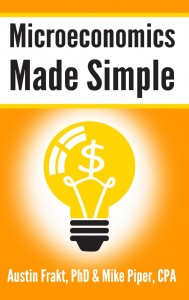The following is a lightly edited excerpt of sections from Chapter 7 and 8 of Microeconomics Made Simple, by Austin Frakt and Mike Piper. You can find a summary of the book, its table of contents, and links to other excerpts here.
Economic Costs vs. Accounting Costs
A firm’s “accounting costs” are all the financial costs it incurs to produce output. For example, for Pauline’s Pies—a business that makes frozen pizzas—accounting costs would include rent, labor, ingredients, utility bills, insurance, and any licensing fees the business must pay. A firm’s “accounting profit” (or loss) is equal to the firm’s revenue, minus the firm’s accounting costs.
A firm’s “economic costs” include the firm’s accounting costs as well as opportunity costs. For Pauline’s Pies, the economic cost of producing frozen pizzas would include all of the accounting costs listed above, as well as the opportunity cost of producing frozen pizzas (e.g., the profit that the firm could have earned by producing frozen ravioli instead of frozen pizza, if ravioli is the next-most-profitable use of the firm’s resources). A firm’s “economic profit” (or loss) is equal to the firm’s revenue, minus the firm’s economic costs.
The concept of economic profit is crucial because firms make decisions based on economic profits rather than accounting profits. That is, firms want to maximize their economic profits rather than accounting profits. Since our focus is economics and not accounting, we use the term “costs” to mean “economic costs” and “profit” to mean “economic profit” unless otherwise indicated.
EXAMPLE: Pauline knows that by running her frozen pizza business, she can bring in $100,000 of revenue per year, with $60,000 of accounting costs. In other words, by running her frozen pizza business, Pauline can earn an accounting profit of $40,000 per year.
Given these facts, does it make sense for Pauline to run her pizza business? We have no way of knowing the answer unless we also know how much Pauline could earn by doing something else.
If Pauline could earn $50,000 per year in accounting profit making frozen raviolis, she would be losing (forgoing) $10,000 per year by making frozen pizza. In other words, the fact that Pauline could generate an accounting profit of $40,000 is not a sufficient reason for her to run a frozen pizza business. Pauline is concerned with maximizing her economic profit, and due to the $50,000 opportunity cost of making frozen raviolis, her pizza business would actually incur an economic loss of $10,000. (That is, overall, Pauline is $10,000 worse-off by running the pizza business than she is if she runs a ravioli business.)
Average Total Costs
A firm’s “average total cost” is simply its total costs, divided by the number of units produced. Average total cost is an important concept because a firm cannot earn an economic profit selling a good unless its unit price is above average total cost. For example, if Pauline’s Pies incurs costs of $6,000 in a given month and produces 1,000 frozen pizzas that month, the firm’s average total cost is $6. If the price of a frozen pizza is above $6, the firm will earn a profit. Otherwise, it will not.
How to Calculate Economic Profit (or Loss)
At any given point of production, Pauline’s Pies’ total revenue (TR) is equal to the market price of a frozen pizza (P), multiplied by the quantity of pizzas sold (Q). That is:
TR = P × Q.
And at any given level of production, Pauline’s Pies’ total costs (TC) are equal to the average total cost of production (ATC) multiplied by the quantity produced (Q). That is:
TC = ATC × Q. (Remember, ATC is TC ÷ Q.)
So when producing at quantity Q, Pauline’s Pies’ economic profit (or loss, if negative) will be calculated as:
Profit = (P × Q) – (ATC × Q), or
Profit = (P – ATC) × Q.
If the market price (P) is greater than average total cost (ATC) at quantity Q, Pauline’s Pies will earn a positive profit (i.e., the expression above will be positive). If average total cost at quantity Q exceeds the market price, Pauline’s Pies will incur a negative profit (i.e., a loss, because the expression will be negative).
The above is a lightly edited excerpt from Microeconomics Made Simple (Copyright © 2014 Simple Subjects, LLC.) You can buy the book at Amazon.com.


